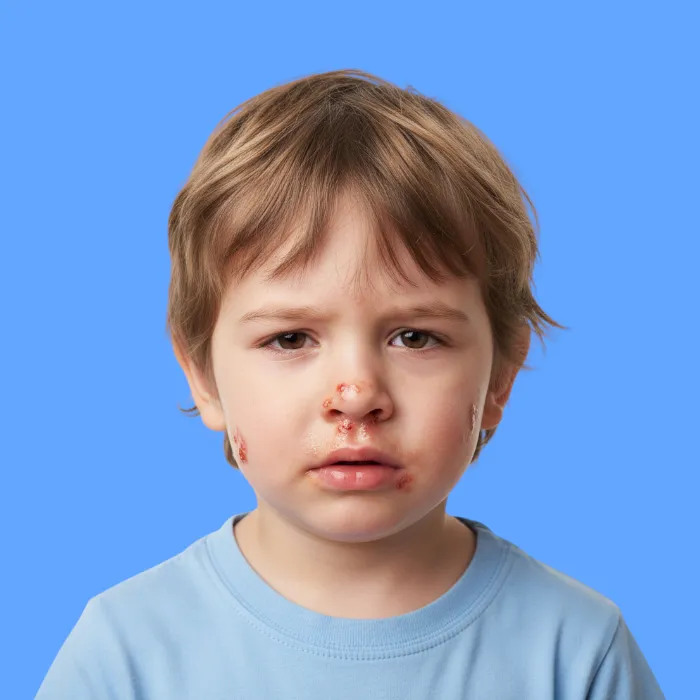What is Impetigo?
Impetigo is a common superficial skin infection that primarily affects children. It spreads easily from one person to another and appears as small blisters that turn into golden crusts, rapidly spreading across exposed areas of the body.
It is known for its ease of transmission in crowded places like schools and may cause annoying itching or discomfort.
What are the common causes of Impetigo?
There are several common causes of impetigo, including:
- Contact with infected skin from another person.
- Using contaminated personal items such as towels or clothes.
- Presence of small cuts or scratches that allow bacteria to enter.
- Weak immunity or other skin conditions like eczema.
- High temperature and humidity that promote the spread of infection.
- Not washing hands regularly after touching public surfaces.
- Sharing toys or school supplies among children without sterilization.
- Frequent scratching of the skin, which causes irritation and opens the way for bacteria.
What are the symptoms that may indicate infection?

There are several common symptoms that a patient may experience, including:
- Appearance of small blisters filled with clear or yellow fluid.
- Formation of golden crusts over the blisters after they burst.
- Rapid spread of blisters across different areas of the body.
- Itching or burning sensation at the site of infection.
- Redness of the skin surrounding the blisters.
- Mild swelling of nearby lymph nodes.
- Peeling of the skin in affected areas.
- Sometimes a slight fever in children.
When should you see a doctor?
It is recommended to see a doctor immediately if any of the following occur:
- Symptoms persist for more than a week without improvement.
- Blisters spread quickly and become bothersome.
- Signs of inflammation such as swelling or severe pain appear.
- More than one person in the same household shows similar symptoms.
- History of weak immunity or chronic illnesses.
- Appearance in sensitive areas like around the eyes or mouth.
- Skin does not respond to home treatments or antiseptics.
- Pus or unusual odor appears from the infected area.
What are the available treatments for Impetigo?
There are several treatment options for impetigo, including:
- Using antibacterial creams or ointments.
- Gently cleaning the infected skin with topical antiseptics.
- Avoiding scratching or touching the blisters to reduce spread.
- Covering affected areas with clean gauze to reduce infection.
- Washing hands thoroughly after handling infected skin.
- Taking oral antibiotics in severe cases.
- Avoiding sharing personal items with others.
- Following up with the doctor to assess treatment response.
Can complete recovery be achieved?
Yes, complete recovery from impetigo is possible in most cases, especially if treated early and properly.
The speed of recovery depends on the extent of the infection, the body's response to treatment, and adherence to personal hygiene.
What are the prevention tips?
There are several tips to prevent impetigo, including:
- Washing hands regularly with soap and water.
- Avoiding contact with infected skin of others.
- Not sharing personal items like towels and clothes.
- Cleaning wounds and scratches immediately.
- Keeping nails clean and trimmed regularly.
- Using skin antiseptics in public places.
- Teaching children not to scratch or touch blisters.
- Ventilating closed spaces and reducing humidity.
What are the possible complications?
Some complications may occur if treatment is neglected, such as:
- Spread of infection to larger areas of the skin.
- Deep skin inflammation or abscess formation.
- Transmission of infection to other household members.
- Appearance of scars or permanent skin discoloration.
- Kidney inflammation in rare cases.
- Bacterial resistance to antibiotics.
- Recurrence of the same infection in the future.
- Negative psychological impact on the child due to skin appearance.
Frequently Asked Questions about Impetigo
Is impetigo contagious?
Yes, it spreads easily from one person to another.
Does impetigo affect adults?
Rarely, but it is possible especially in cases of weak immunity.
Can impetigo be treated at home?
In mild cases, yes, with proper care and hygiene.
How long does recovery from impetigo take?
Usually 7 to 10 days in typical cases.
Article Summary
Impetigo is a common and easily transmitted skin infection, but it is treatable and curable if addressed early. Personal hygiene and awareness of symptoms are key to prevention.
It is always recommended to consult a doctor when any unusual signs appear, especially in children, to avoid potential complications.